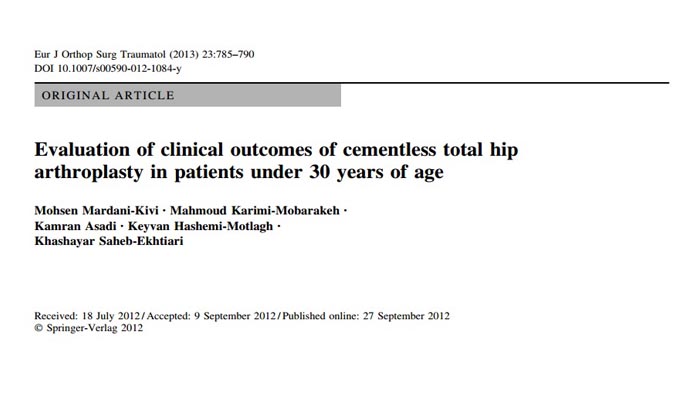- تاریخ درج : ۲۹ فروردین ۱۳۹۶
- تعداد بازدید: 2654
- نویسنده : dr.mohsen mardani-kivi
-

BACKGROUND:
Historically, performing a successful hip joint replacement in patients aged fewer than 30 years has been an orthopedic challenge. The newer generation of prostheses and surgical techniques has the potential to increase the longevity of implants. The purpose of this study was to evaluate the outcomes of cementless hip arthroplasty in patients aged fewer than 30 years.
MATERIALS AND METHODS:
In this cross-sectional study, 41 patients (46 hips) were studied with a mean age of 24, 4 (from 17 to 30 years) of whom underwent cementless metal-polyethylene hip arthroplasty from 2004 to 2007. The Harris hip score (HHS) was used to assess the functional consequences. Patients were followed up in terms of early complications (thrombophlebitis of the lower limbs, dislocation, hematoma and infection) and late complications (aseptic loosening, dislocation and reoperation) at weeks 3 and 6, at 3 and 6 months, 1 year after surgery and annually thereafter.
RESULTS:
Patients were followed for an average of 5 years and 2 months (from 51 to 82 months). One early complication (symptomatic thrombophlebitis) and one late dislocation (2.2 %) were observed. There were no cases of aseptic loosening or osteolysis at the end of follow-up. The preoperative HHS was 59.6 (from 41 to 76), which rose to 82 and 83.5 after the 1-year and final follow-up, respectively, which was a significant increase.
CONCLUSIONS:
Hip arthroplasty using a new generation of cementless proximal porous prosthesis with resistant polyethylene to cover the joint surfaces in patients aged fewer than 30 years is satisfactory and is accompanied by low complications.
-